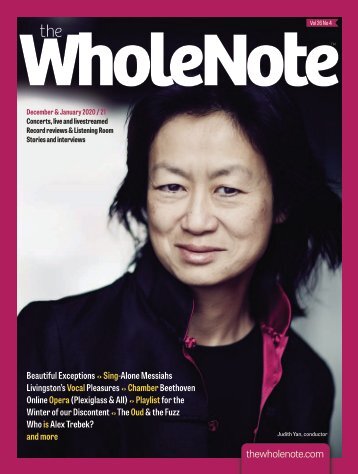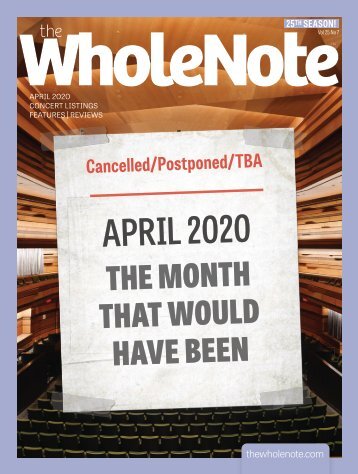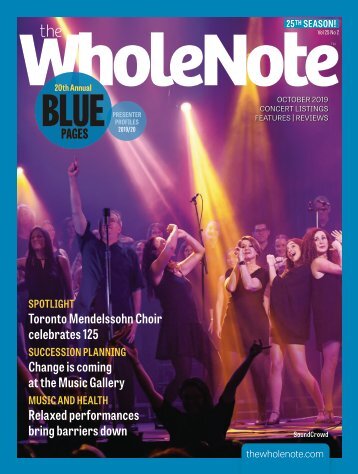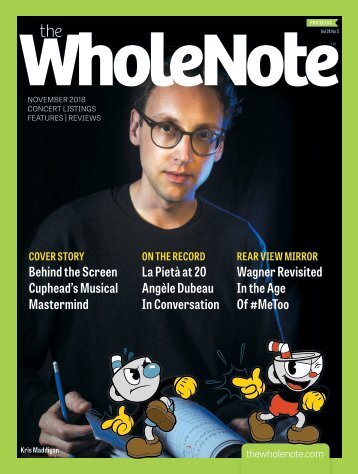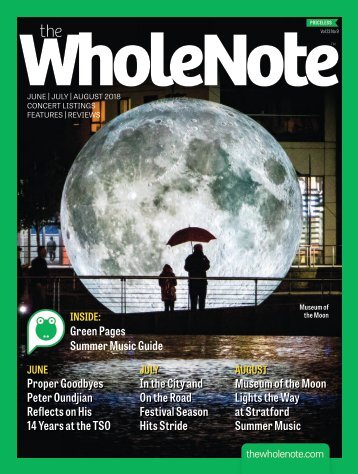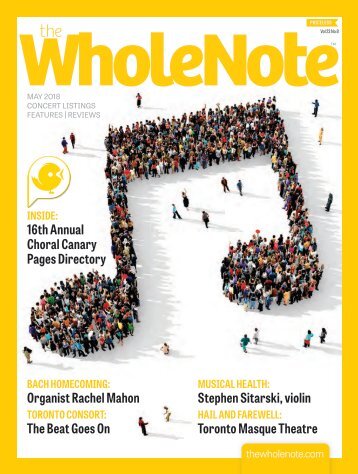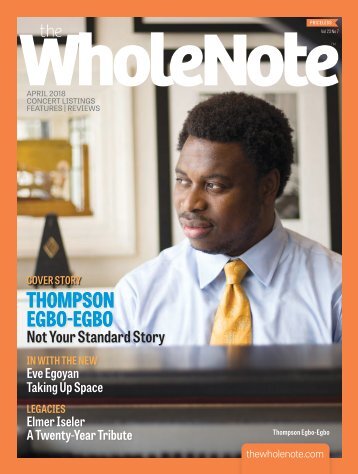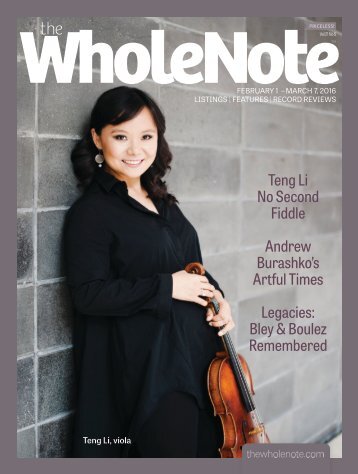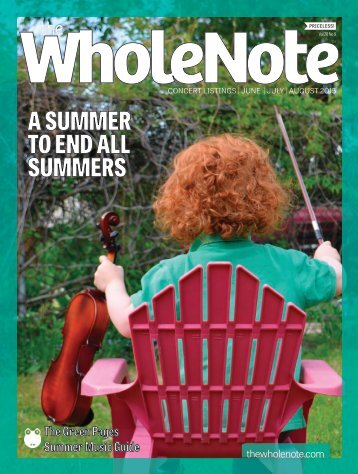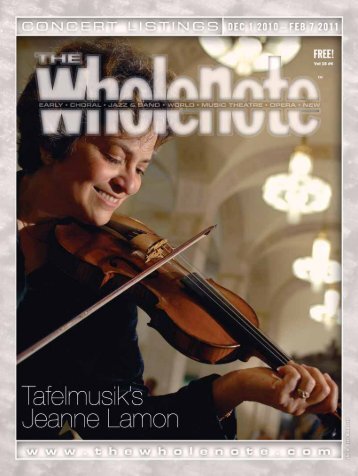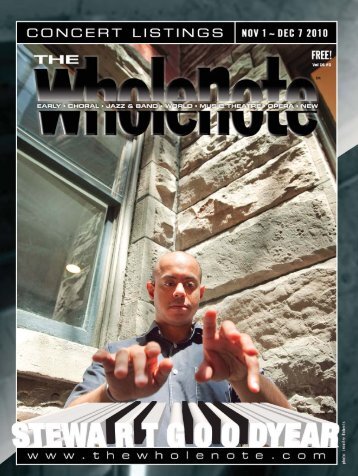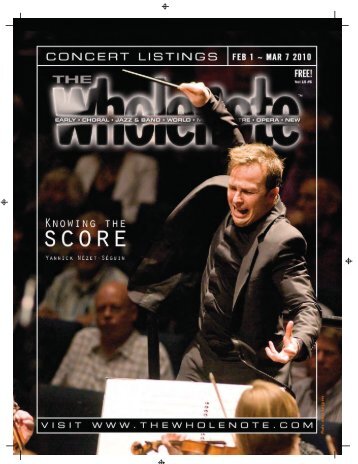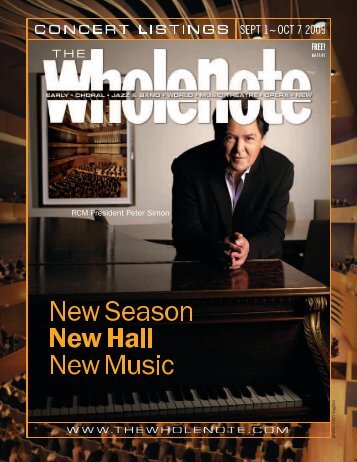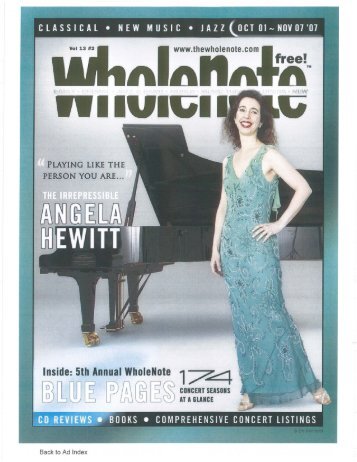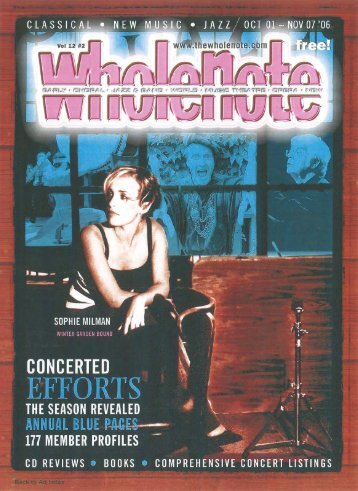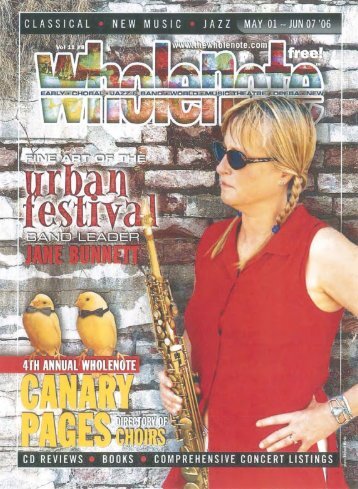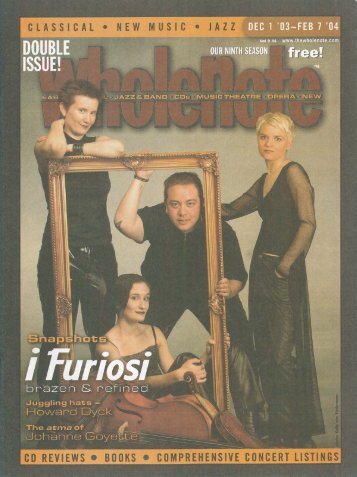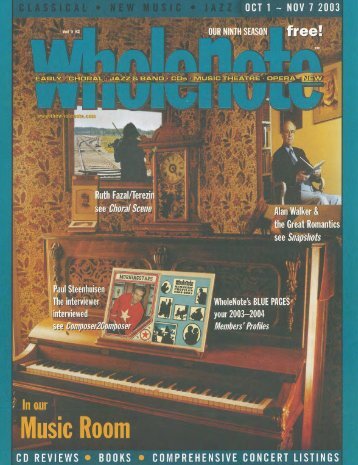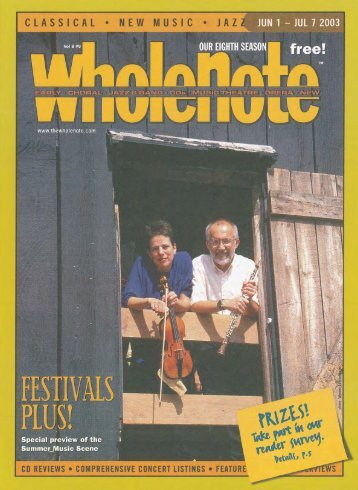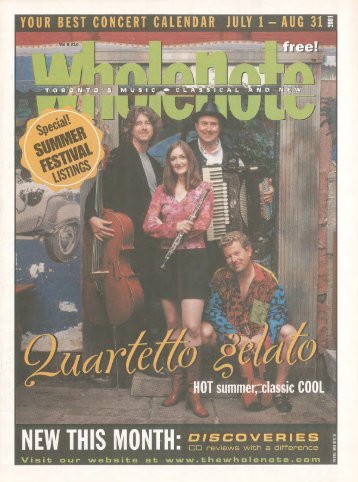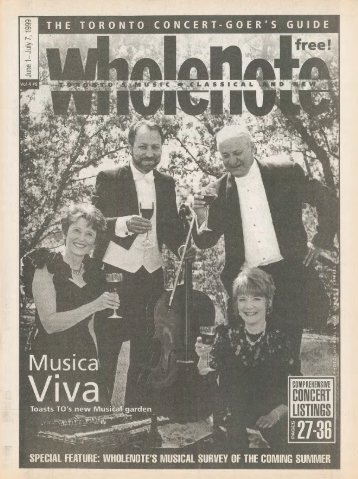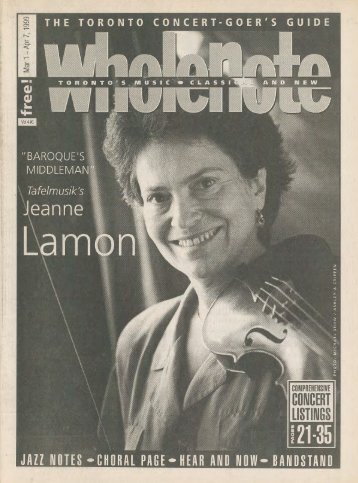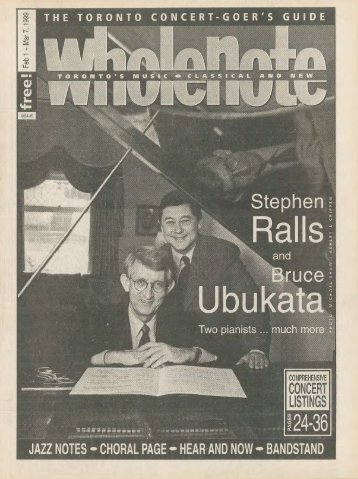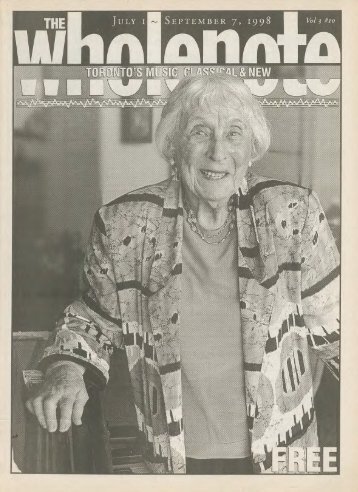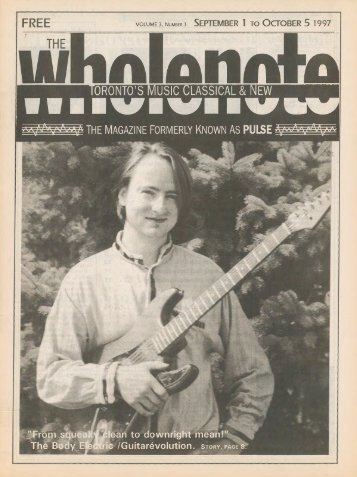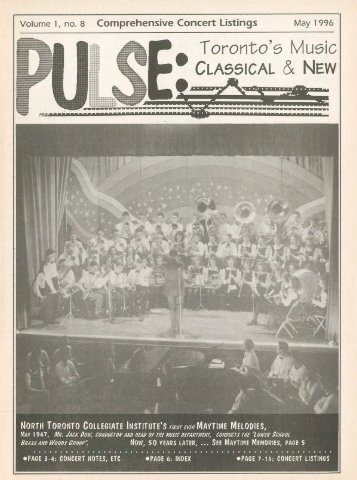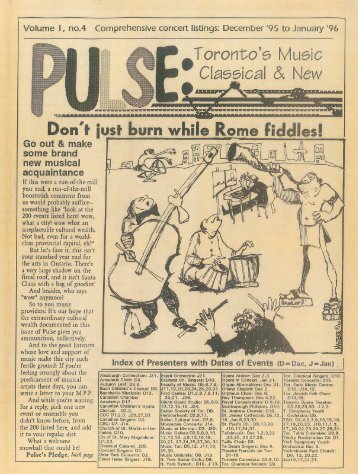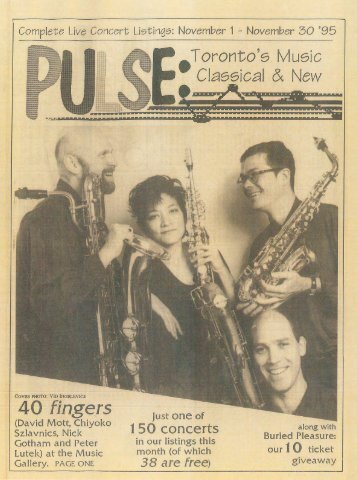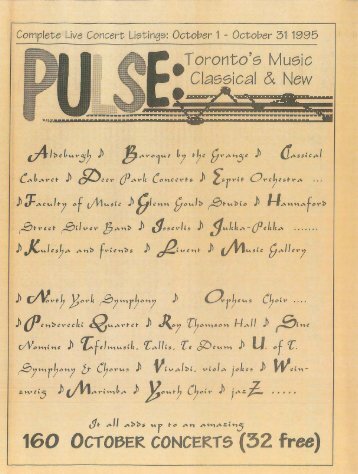Volume 18 Issue 1 - September 2012
- Text
- September
- Jazz
- Toronto
- October
- Gould
- Sept
- Theatre
- Musical
- Concerts
- Symphony
Beat by Beat | World
Beat by Beat | World ViewJohn Cage,Master of SilenceANDREW TIMARReflecting on this month’s slew of anniversaries, I am markingon my calendar the 100th year of American composer JohnCage’s birth, on September 5, and the 20th of his death. Whatdoes Cage the multi-faceted avant-garde modernist, the influentialcomposer, music theorist, author, mycologist, poet, lecturer, musicianand master of silence have to do with world music, our column’s purview?This is the subject of the present column’s lead story.English musicologist David Nicholls, in his 1996 essay“Transethnicism and the AmericanExperimental Tradition,” argues that theinfluence of musical transethnicism — abranch of experimental music allowing formixing recognizable music genres oftenfrom differing cultures — on Cage’s compositions,is less overt than in the work ofsome his colleagues such as Lou Harrison,tending to be “ideological ... rather thanthe musical sounds or techniques.” Formuch of Cage’s career that may be the case;however there is a significant Cage workcomposed for a Toronto world music groupin the last decade of his long and prolificcareer that may suggest differently.My interest in Cage’s music is highlypersonal: it began in my last years of highschool, mediated by shiny new LPs. Duringmy undergrad years at York Universitythis vinyl-based curiosity developed intoan active interest. I studied and played hismusic under the tutelage of Cage’s studentsand colleagues such as compositionprofessor James Tenney. In the 1970s andYokohama, 1986.1980s Cage’s avant-garde celebrity was growing and there seemed tobe ample opportunity to see him here in person. New Music Concertsbrought him to Toronto repeatedly. I also attended a performanceof the touring Merce Cunningham Dance Company at the RoyalAlexandra Theatre, a company he was associated with for five decadesas musician, composer and music director.Canadian composer Udo Kasemets, an early Cage follower andadaptor, had performed Cage’s Suite for Toy Piano in 1963. Kasemetssubsequently brought Cage and Marcel Duchamp to Toronto to performat the Ryerson Theatre in 1968. By 1981, along with composerMiguel Frasconi, I felt well enough acquainted with Cage’s work totackle an interview with him, published in Musicworks. My creativeintersection with Cage and his work culminated in 1986/87. It wasduring that exciting time that I witnessed, firsthand, the genesis ofCage’s Haikai, participating in extensive rehearsals of the score and inthe premiere performance.Haikai was composed not for a new music group of Western concertinstruments, but for the gamelan ensemble of the Toronto-basedEvergreen Club, founded in 1983 by Canadian composer Jon Siddall.The group consisted of eight professional musicians who collectivelyplayed a particular type of gamelan called degung, indigenous to theWest Javanese region of Indonesia. The Evergreen Club was Canada’sfirst performing gamelan and by the mid-1980s the group was beginningto make a name commissioning dozens of new works, performingthem about town and recording them for broadcast on the CBC.In 1986 John Cage was approached by Siddall, EC’s artistic director,to come visit its gamelan degung, Si Pawit, a name which in theSundanese language of West Java means “honourable foundation.”James Tenney (still at York University) was already writing a piecefor prepared piano and gamelan degung for an upcoming EC concert.Tenney was a former Cage student and Siddall took advantage of thatpersonal connection to call Cage to inform him of his plan to combineCage’s 1940 invention, the prepared piano, with gamelan. DuringCage’s next lecture trip to Ontario, he visited the Beach neighbourhoodof Queen St. E. where Siddall and his Si Pawit resided. I was totake part in Cage’s brief visit, and was on my way down Leslie St., butwas unfortunately stuck in a minor gas-station fender bender. The following,therefore, is my, alas, second-hand account of John Cage’sonly visit to Si Pawit, which I share with you for the first time, courtesyof my long-time friend and colleague Jon Siddall who served asCage’s sole host and gamelan degung guide in my absence.On arrival, Cage set to work exploring the individual characteristicsounds of the Si Pawit instruments with his own hands. In theCageian spirit of playful experiment he turned the rows of gongs oftwo of the instruments, bonang and jengglong, upside-down andplayed their rims with mallets. The resulting unpredictable sounds sodelighted him that he scored upended gongs, bowed andcoaxed with mallets of graduated hardness, at the heartof his new work. His imagination wandered one stepfurther: he wondered about spinning the gongs on thefloor on their knobbed centres! Siddall knew then thatCage “was hooked.” Cage however stopped himself fromtaking that particular radical action, thinking out loudthat it might not be beneficial for the instruments.Cage worked on Haikai (1986) during a busy time inhis career. He had begun work on his first opera project,Europeras 1 & 2, and I find it remarkable that he madethe time to prepare a new work for a young, as yet littleproven, gamelan group in Toronto. Perhaps it wasEvergreen Club’s dedication to numerous rehearsals tofinesse new compositions that secured Cage’s dedicationto the project. In three weeks the beautifully hand writtenscore — even the organic looking staff was drawn byCage’s pen — was completed and sent. The work is dedicated“for Si Pawit, gamelan degung of the EvergreenClub.” This collegial dedication reveals Cage’s focus onthe individual characteristics of this particular gamelan(Si Pawit), and also honours the performing group, themusicians who bring the score to life.The commission didn’t go unnoticed by the localmedia. Toronto Star music critic William Littler, in his previewarticle “Ensemble to Debut Asian-influenced Cage Work,” takes abemused, if friendly, stance. “There, in a second-floor Richmond St.studio the other night, sat eight men in stocking feet, squatting beforea collection of bronze gongs and xylophones, wooden drums and asingle flute ...”For all of its innovation — the gongchimes turned upside down,bowed gong rims and what the score calls “Korean unison” (essentiallychords of unmeasured entry, dynamic and duration) — the scorereflects in its open spirit aspects of idiomatic gamelan practice withconsiderable sensitivity. This is a surprisingly canny achievement fora composer who had not formally studied any sort of gamelan instrumentationor had musical practice in it. Haikai does however bear theearmarks of two of the structural forms Cage adopted from Asian literarysources and repeatedly used in his compositional method: theI Ching, and haiku, the Japanese poetic form. The poetic haiku structuretypically consists of the syllable count 5:7:5 spread over threelines. Cage adapted this structure in Haikai, through hand gesturesindicating silences, notated in the score in the conventional manner,by fermata.In Evergreen Club gamelan’s April 5, 1987, premiere performanceat Toronto’s Premiere Dance Theatre, it is precisely during thesefermata-marked moments in Haikai, when the performers are attentively“resting” yet actively listening, that the real Cageian magicemerges. It is only then that the customary invisible wall between performersand audience, and the physical one between the concert halland the sounds of the outside world, become permeable, and are ableAKIRA KINOSHITA, COURTESY OF THE JOHN CAGE TRUST14 thewholenote.com September 1 – October 7, 2012
2012 ~ 2013 Subscription Seriesst41 SeasonGREAT CHAMBER MUSIC DOWNTOWNQUARTETS3, 1BRENTANOQUARTETTh. Sept. 13ATTACCA QUARTETTh. Sept. 27PHILHARMONIAQUARTETTBERLINTh. Oct. 11GRYPHONTRIOTh. Dec. 6ST.LAWRENCEQUARTETTh. Jan. 31TOKYOQUARTETTh. Jan. 10FAURÉ PIANOQUARTETTTh. Feb. 28TOKYOQUARTETTh. Apr. 4PIANO9, 9JOHNO’CONORTu. Oct. 30GEORGE LITu. Dec. 11DISCOVERY KAORI YAMAGAMAcellistTh. Jan. 17ERIN WALLsopranoTh. Mar. 7MARC-ANDRÉHAMELINTu. Jan. 22GABRIELLEMONTEROTu. Feb. 12RACHEL KIYOIWAASATu. Mar. 19TRIOFIBONACCITh. Mar. 14atAll concerts at 8 pmSubscriptions available. Single tickets on sale Sept 4.416-366-7723 1-800-708-6754order online at www.stlc.comlCanadianHeritagePatrimoinecanadien
- Page 1 and 2: Vol 18 No 1Producers/EngineersBilly
- Page 5 and 6: Volume 18 No 1 | September 1 - Octo
- Page 7 and 8: Robert Aitken, artistic directorSun
- Page 9 and 10: landmark productions (Caucasian Cha
- Page 11 and 12: RCM_WHOLENOTE_4c_fullpage_Sept 12-0
- Page 13: 2012-13seasonSEASON HIGHLIGHTSBerli
- Page 17 and 18: Beat by Beat | Classical & BeyondFo
- Page 19 and 20: WholeNote_JSQ.v2:Layout 1 8/17/12 4
- Page 21 and 22: SinfoniaTorontoNURHAN ARMANMUSIC DI
- Page 23 and 24: Beat by Beat | Early MusicStrings t
- Page 25 and 26: Brandenburg Concerto No.1, the show
- Page 27 and 28: ANDRÉ LEDUCIt will come as no surp
- Page 29 and 30: COURTESY OF DOMONEY ARTISTSMagdalen
- Page 31 and 32: Beat by Beat | Choral SceneAs Choir
- Page 33 and 34: Look forward later in the fall to A
- Page 35 and 36: new show, Julie Sits Waiting, opens
- Page 37 and 38: (1640) by Francesco Cavalli with Ch
- Page 39 and 40: corporation which sells a range of
- Page 41 and 42: oad selection of music under the di
- Page 43 and 44: music settings of folk songs by Ukr
- Page 45 and 46: .00 and up.Saturday September 15
- Page 47 and 48: for four cellos; Rolfe: Worry for v
- Page 49 and 50: Bloor St. W. 416-231-6016. Free.•
- Page 51 and 52: • 8:00: Kitchener-Waterloo Sympho
- Page 53 and 54: Sep 15 7pm Sam Broverman /(ad
- Page 55 and 56: Every Mon 7pm This is Awesome; 10pm
- Page 57 and 58: • Sep 26 6:30-8:45: Kingsway Cons
- Page 59 and 60: WE ARE ALL MUSIC’S CHILDRENSeptem
- Page 61 and 62: I mentioned earlier in this article
- Page 63 and 64: CLASSICAL & BEYONDTchaikovsky; Niel
- Page 65 and 66:
MODERN & CONTEMPORARYBouliane; Goug
- Page 67 and 68:
Something in the Air | New Exciteme
- Page 69 and 70:
BEAUTIFUL MUSIC FOR A CRAZY WORLDVi
- Page 71 and 72:
A dazzling weekend full ofperforman
Inappropriate
Loading...
Mail this publication
Loading...
Embed
Loading...
























